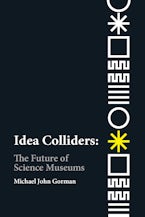Idea Colliders: The Future of Science Museums, by Michael John Gorman. Cambridge: MIT Press, 2020.
REVIEWED BY MICHAEL CRANICK

In Idea Colliders, Michael John Gorman explores the future of science museums. He quotes cellist Yo-Yo Ma about the “edge effect,” a place where spaces are created “to nurture cross-pollination of ideas” (Gorman 2020, 1). Gorman sees this cross-pollination as both the purpose and future of science museums. Looking at current trends, Gorman takes the reader on an exploration of what he believes science museums in the future could look like and how they could accomplish this purpose. He bookends his exploration of science museums between two examples from the Science Gallery at Trinity College in Dublin, Ireland.
Gorman challenges the traditional idea of what a science museum is by sharing the example of an exhibit called Infectious from the Science Gallery. Infectious invited real scientists and artists to create an interactive gallery with activities that involved guests in data gathering, put disease on display, and even involved one contributor using real anthrax in various photos (Gorman 2020, 3). Gorman advocates for exhibits and experiences that bring people from diverse backgrounds together, breaks down barriers to generate new ideas, and pushes the limit in a way that is reminiscent of Frankenstein.
After this shocking introduction, Gorman takes a step back to see where science museums originated and how they are different from art museums and natural history museums. He traces them through cabinets of curiosity to the Exploratorium created by Oppenheimer. For Gorman, the Exploratorium was a success because it did more than just share information. It brought scientists and visitors together by allowing visitors to see how scientists create. Exhibits were created on site, responded to visitors curiosity, and put science on display. This model became incredibly popular, and was shared and copied but also lost what Gorman saw as being essential. What made the Exploratorium successful in Gorman’s eyes was its ability to immediately respond to visitors. The science wasn’t prepacked; it was happening as you watched. It sparked curiosity and innovation. Once exhibits traveled, that responsiveness was lost.
From the Exploratorium, Gorman imagines three possible futures for science museums, the megamuseum mall, the cloud chamber, and the invisible museum. Each is an extreme. The megamuseum mall is an extreme example of branding. Technology is integrated into every facet, and the experience is sculpted to each individual visitor. It is instant gratification. The cloud chamber is all about conversation, connection, and interaction. Gorman likens the cloud chamber to the old fashioned coffee houses and salons where ideas are exchanged and inspired. It is less about exhibits and objects, and more about intellectual experiments. The invisible museum asks if museums even need walls. Do they need to be a physical place? With technology advancing and collections being digitized, content could be shared with individuals without them ever needing to go to a physical building. It would be individual, but it would also be isolated.
Gorman uses these extreme examples to make the point that there is no “one size fits all” for science museums (Gorman 2020, 101). Gorman argues that science museums need to move beyond simply presenting science. They need to move beyond interactions that are simple button pushing. They need to move beyond just being focused for children. Science museums need to make a case for being for young adults. Science museums have the potential to address the disconnect between scientists, science, and the public so that issues like climate change and pandemics can be addressed.
Gorman’s final example returns to the Science Gallery. Michael John Gorman helped to launch the Science Gallery at Trinity University. He redirected it from being scientist led and focused on nanotechnology, to being focused on a collaboration between art and science. He continues to do exhibits like Infectious which push boundaries and spark conversations. The conversations spurred by these galleries have been the biggest surprise for Gorman. These conversations are where Yo-Yo Ma’s edge effect happens. Many of the visitors questioned after going to the Science Gallery repeatedly shared that their interactions with the staff were the best part of their experience. Conversations created connections and made the science real. They allowed for questions that lead to curiosity. The connections also built trust.
Though Gorman argues that more collaboration behind the scenes is the future of science museums, his experience with the Science Gallery shows the importance that collaboration in the galleries plays in connecting visitors to science and innovation. Gorman misses the importance interpreters and gallery staff play in making the connections he says are vital to the future of science museums. He focuses so much on extreme examples of what science museums can accomplish with unique collaborations behind the scenes that he seems surprised by the impact and importance of the collaborations happening between guests and gallery interpreters. Gorman is correct that science museums need creative collaboration from their inception, but his own experiences demonstrate that collaboration happening with guests and staff in galleries is just as vital to a successful exhibition, gallery, and museum.
Michael Cranick is a first year MA student in the Museum Studies Program at IUPUI. He has a Bachelor of Arts in Anthropology from Indiana State University.

